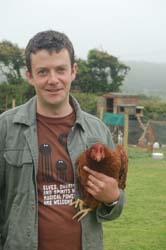Grow it Yourself - September
 If you allow it to be, the harvest can be a time of incredible celebration, and it is quite right that it should be so. We should be celebrating at this time of the year even though it might be kind of quaint to do so. The joy of the harvest is something that the food chain’s assault on seasonality has deprived us of, for if every vegetable is available all the year round, then of course there is no reason to celebrate the harvest months.
If you allow it to be, the harvest can be a time of incredible celebration, and it is quite right that it should be so. We should be celebrating at this time of the year even though it might be kind of quaint to do so. The joy of the harvest is something that the food chain’s assault on seasonality has deprived us of, for if every vegetable is available all the year round, then of course there is no reason to celebrate the harvest months.
As GIYers, we reclaim the joy of the harvest: fruit trees laden down with fruit and the veggie patch heaving with produce; lifting crops and getting them in to storage; shelling, dicing, chopping and pickling in preparation for the winter months ahead. Don’t forget to take time to enjoy the fruits of your labour and have heroic meals in convivial company!
 Here at GIY HQ we are busy with our own harvesting, but we’ve also just enjoyed the annual GIY Gathering which took place in Waterford City on September 10th and 11th. It was the largest meeting EVER in Ireland of people that are interested in growing their own food, and was a wonderful opportunity to celebrate the harvest and to get inspiration from other GIYers from across the country.
Here at GIY HQ we are busy with our own harvesting, but we’ve also just enjoyed the annual GIY Gathering which took place in Waterford City on September 10th and 11th. It was the largest meeting EVER in Ireland of people that are interested in growing their own food, and was a wonderful opportunity to celebrate the harvest and to get inspiration from other GIYers from across the country.
There were over 40 workshops, talks, demos, panel discussions, debates, expert Q&As, and forages over the two days with speakers includinging Joy Larkcom, Bob Flowerdew, Darina Allen, Ella McSweeney, Suzanne Campbell, John McKenna, Klaus Laitenberger and yours truly.
Things to Do this Month – September
To-Do
Lift crops which have finished growing and dress bare soil with manure, compost (or plant green manures). Wasps can be problematic as fruit ripens so make traps from jars of sugary water. Remove surplus leaves from tomato plants which allows air to circulate and sunshine to fall on the fruit. Go blackberry picking!
Sowing Seeds
Last month for sowing perpetual spinach, chard and oriental salads – it will be worth it in the New Year when there’s almost nothing else to eat, so get sowing! In the polytunnel/greenhouse sow lettuce, mustard, coriander, parsley, radish, dwarf early pea, broadbean, cauliflower seed, rocket, onion seed and garlic. Outside sow white turnip seeds and autumn onion sets, e.g. ‘centurion’ and ‘sturon’. Plant out strawberry runners. Pot up some parsley for winter use.
Harvest
Summer vegetables and fruit are joined by the great autumn veg like parsnips, swedes and celeriac. Lift onions and leave to dry out in sun or in the polytunnel/greenhouse for two weeks. Apples, plums, pears are now in season. Continue to harvest salad leaves, tomatoes, radish, potatoes, carrots, turnips, beetroots, cauliflower, cucumbers, peppers, beans, courgettes, spinach, leeks, red cabbage, summer cabbage, aubergine, sweet corn.
Recipe of the Month – Piccalilli
Cauliflower needs to be harvested as soon as it’s ready (you can’t leave it in the ground or the curds start to open) and it doesn’t store particularly well once picked – so here’s a good recipe for an exotic pickle called Piccalilli that will help you keep it for 6 months. It also uses up some of those other “glut” vegetables like beans and courgettes.
Ingredients
• 1 large cauliflower
• 2 large onions, peeled and quartered and sliced finely
• 900g mixed veg such as courgette, runner beans, carrots and green beans – cut in to bite sized chunks
• 60g salt
• 2tbsp plain flour
• 225g sugar
• 1 tbsp turmeric
• 60g English mustard powder
• 900ml pickling Vinegar
Put all the vegetables in a large bowl. Dissolve the salt in 1.2l of water and pour this over the veg. Put plate on top to keep them submerged and leave for 24 hrs. Drain and rinse the next day.
Bring a large pan of water to the boil – add the veg and blanch for 2 minutes. Drain and refresh in cold water.
Put flour, sugar, turmeric and mustard in a small bowl and mix in a little of the vinegar to make a paste.
Put it in a large stainless steel saucepan along with remaining vinegar, bring to the boil and stir continuously so that no lumps appear. Reduce heat and simmer for 15 mins.
Add veg to the sauce and stir well so they are coated. Ladle in to sterilised jars and use a non-metallic lid to seal. Allow to mature for one month before using. This recipe will make 5lbs.
 Tip of the Month – Saving Tomato Seeds
Tip of the Month – Saving Tomato Seeds
If you had a variety of tomato that was a particular success this year, why not try saving the seeds from the tomatoes to grow next year’s plants? You should only save seed from open-pollinated varieties of tomatoes, and not hybrids.
Pick a nice big, ripe tomato and cut it in half. Squeeze the contents (seeds, gel and juice - not flesh) in to a cup or container and label the cup with the variety. Half fill the cup with water. After a few days a mould will form on the water, which is a sign that the seed coating has dissolved.
Pour off the water and any floating seeds (these are duds that wont germinate). The good seeds should be on the bottom of the cup. Rinse the seeds under a cold tap in a very fine mesh strainer.
Put the seeds in a single layer on a paper plate and leave for a few days to dry. Bag them up in a labelled envelope and store them somewhere cool (or refrigerate) until next spring.
------------------------------------
We are trying to get 100,000 people to take a pledge to grow something they can eat – take the GIY pledge at www.facebook.com/giyireland.
 Michael Kelly is a freelance journalist, author and founder of GIY Ireland.
Michael Kelly is a freelance journalist, author and founder of GIY Ireland.
GIY is a registered charity that inspires people to grow their own and gives them the skills they need to do so successfully. There are 80 GIY groups around Ireland and 6,000 GIYers involved.
For more tips, information and support visit www.giyireland.com.
© GIY Ireland 2011 – all rights reserved.






There are currently no comments
Leave a comment
Not a member? Register for your free membership now!
Or leave a comment by logging in with: